Introduction
This paper examines the importance of the right of looked-after and accommodated children in Scotland to follow their personal, cultural, religious and spiritual beliefs. This is a broad canvas which I will approach from the perspective of religious and spiritual needs. As will be seen, these are inextricable from personal and cultural beliefs. In this paper, the terms 'young person' and 'child' are used interchangeably to include both children and young people. Also, I would like to stress that the paper represents my personal reflections and does not represent the views of the Care Commission in Scotland.
Antipathy towards religious belief
The right of children to follow their own religious and spiritual beliefs appears deceptively straightforward but, despite its legal support, this right does not appear to be universally valued. The antipathy of some toward the right of children to pursue their religion is highlighted by recent newspaper correspondence with one writer (McBay, 2008) complaining of religious believers being “graced with privileged treatment”, another referring to the right of a child not to be “educated, conditioned or indoctrinated” to believe in religions that cannot be proved to be factual or representing the truth (Carson, 2008).
Despite such sentiments, 67 per cent of Scottish people claim a religion (Scottish Executive, 2005a). Sixty-five per cent identify themselves as Christian although only 11.2 per cent of Scots attend church on an average Sunday (Christian Research/ Church of Scotland, 2003). The second largest religious group is Muslim, representing fewer than one per cent of those claiming a religion. Apparently, even among non-adherents, religion is valued in some way by a sizable majority; however, the spirituality of the significant minority who claim no religion should not be ignored.
The right to follow religious and spiritual beliefs
Spirituality is concerned with the inner self and has been described as the “unification between Self and Other” (Hyde, 2008, p.44) which, in the Abrahamic traditions, is concerned with a right relationship with God. A secular definition of spirituality refers to “a person's non-physical being, composed of their character and emotions” (Oxford English Dictionary, 2008). This has been described as “coming from our deepest humanity” (Crompton, 2001, p.6).
Notwithstanding the antipathy already described, the foundation values of care regulation include:
The right of service users to freedom of movement and expression, human rights, cultural, racial and spiritual identity (TOPSS, 2008, p.51).
These are fundamental rights which weave through the various layers of human rights legislation and guidance. This can be seen from the following table:
Table One:
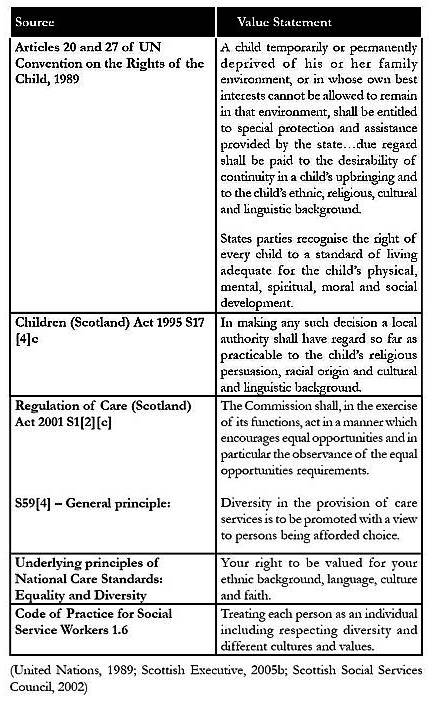
Considering these measures, surprisingly little attention is given to religious and spiritual needs in the personal plans of looked-after children. Although looked-after children's paperwork includes provision for addressing these rights, it is frequently not completed (Berridge and Brodie, 1998; Barn et al., 1997; Crimmens and Milligan, 2005), even for unaccompanied asylum-seeking children, whose ethnic origin was frequently recorded as “other” (Wade et al., 2005). Research also confirms that children, including those with no religious background, have the capacity for a “rich spiritual dimension” in their lives (Hyde, 2008, p.20; Walker, 2005). Hence it is clear that this area needs to be addressed.
Religious sectarianism
Negative views of religion derive, in part, from Scotland's sectarian history. I was confronted with this when I arrived in Scotland in 1982. I was unaware that melodic flute music played by one group might be experienced as provocative by others! Soon after this, a colleague from another residential setting told me of a staff member refusing to support the church attendance of a child of another Christian denomination.
As a care regulator, I still encounter sectarian sensitivities, for example, the young person who wanted me to support their right to display paramilitary regalia in their room. We need to be clear about what constitutes valid expression of religious and cultural identity and what is unacceptable. In this instance it became clear that the issue was not concerned with spirituality but deeply-rooted sectarian beliefs. For the young person, this was an important aspect of their cultural identity. Sectarianism still plays a part in the lives of many people in Scotland (O'Loan et al., 2005; Scottish Executive, 2005a). As in Northern Ireland, many of Scotland's children and young people’s religious and cultural identities are “interwoven into the sectarian and political context” (Kelly and Sinclair, 2005, p. 331). Against this backcloth, workers may feel averse to addressing religion, much like colleagues in Northern Ireland.
Scotland's changing culture
Many Scots have grown up with this sectarian backcloth but we are now a multi-cultural society. We face new challenges, including the arrival of asylum seekers and migrants from the EU accession states. Between 1991 and 2001, the size of the ethnic minority population in Scotland rose by 62.3 per cent while the overall population increased by only 1.3 per cent (Care Commission, 2008). Table Two shows the number of looked-after children from ethnic minority backgrounds.
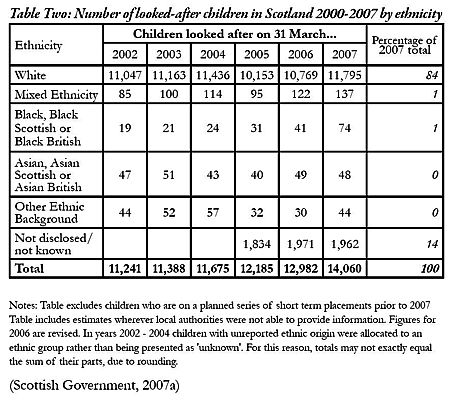
The trend is slowly upward for those of mixed ethnicity and Black, Black Scottish or Black British ethnicity, and commentators suggest that this will continue (Crimmens and Milligan, 2005) as part of an evolutionary process (Allain, 2007). Additionally, migration from the EU accession countries has been accompanied by an increase in practicing Roman Catholics (Scottish Government 2007b). Meanwhile, the focus of discrimination is thought to be shifting from Catholic-Protestant sectarianism to Islamaphobia, refugees and asylum seekers (Rose, 2008). Discrimination is claimed by some to be “less about skin colour and more about creed” (Ross, 2008, p. 14). Notably, the youngest recorded age-profile for any religious group in Scotland is for Muslims with 31 per cent aged under 16 years, contributing to fears of the radicalisation of young Scots-Muslims (Davis, 2008; Howie, 2008). Against this complex backcloth, various factors, including misplaced political correctness, result in practitioners feeling de-skilled where religion, spirituality and culture is concerned, as evidenced in the following statement:
Why are we all so hesitant, wary, cagey and downright scared about issues of “race and culture"? What is it about these subjects that have the capacity to freeze us, leave us tongue-tied and afraid of saying or doing the wrong thing? (Walker, 2005, p. 2).
Examination of personal plans often reveals poor consideration of cultural, religious and spiritual aspects, leading to an inference that few white Scottish children have needs concerning cultural, religious or spiritual identity. It might then be expected that staff would be more attentive to those from other ethnic backgrounds (Barn et al., 1997). However, a small survey in respect of the National Care Standards (Stevens and Boyce, 2006) identified staff ignorance of the faith-needs of a Muslim respondent. This led to reactive practice which was, in itself, potentially discriminatory.
Maintaining contact with members of young people’s own faith will be important. Interestingly, the National Care Standards for care homes for children and young people omit the standard concerning the cultural and religious background of staff which is included in the National Care Standards for older people (Scottish Executive, 2005c). Perhaps this is a reflection of the similarly low numbers of ethnic minority staff in Scotland. This is demonstrated in Table Three.
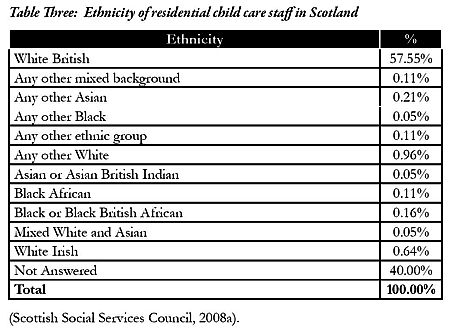
It is also interesting to note that only 13 per cent of residential child care services employed any migrant workers. Given that there has been a recent growth in the number of migrant workers coming to Scotland, this low number is surprising and clearly represents another challenge for providers (Scottish Social Services Council, 2008b).
Supporting the spiritual needs of looked-after children
Even when young people have no religious interest, they are nevertheless spiritual beings whose right to healthy spiritual development is potentially empowering (Hyde, 2008). Residential staff are surprisingly reticent about aspects of their own spirituality, as can be seen in the following table:

Spirituality is about finding meaning and purpose (Walker, 2005). Ignoring or repressing it may disempower children and young people and contribute to emotional and mental health problems (Crompton, 2001; Walker, 2005; Hyde, 2008). A 21 year-old woman described this graphically:
The years from 8-11 I remember as pretty agonising. I was afraid of death, and of life for that matter, and subject to severe panic attacks which nobody seemed to notice. I couldn’t explain them at that age of course, but looking back I don’t really think they were caused by any mental instability but simply by my having reached a religious crisis at a ridiculously early age and being quite unable to cope with it (Crompton, M., 2001, p. 21).
Crompton (2001) identifies a range of considerations in promoting children's spiritual
well-being. Some of these are outlined in Table Five.
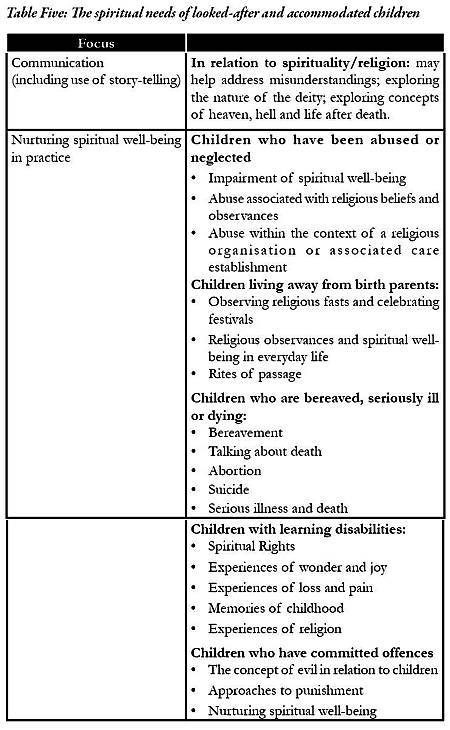
I believe that support of young people’s religious and spiritual needs should include most of the above, whether or not in the context of organised religion. I sometimes see evidence of this being suitably recognised in group settings. For example, at a residential school’s Open Day I attended, input from the school chaplain gave appropriate recognition to pupils' spiritual well-being and development in the context of moving on and making a new start. Personal plans, however, are often confined to whether or not a young person is a church-goer, only occasionally giving any more consideration to their spiritual development, perhaps in relation to issues of grief.
I have sometimes examined personal plans which have addressed culture through consideration of a young person's support for a football team; this has included appropriate consideration of sectarianism and prejudice identifying both the acceptable expression of the young person's cultural background (for example, decorating personal space with team colours) and the unacceptable (for example, wearing team strips in situations where this would be considered provocative). Other personal plans have considered culture from the perspective of musical taste but that can have negative overtones also. An example might be emphasising the need to avoid playing or singing The Sash, rather than considering the recreational and therapeutic benefits of expressing or finding oneself through music.
Developing a culturally competent model of care
The sectarian heritage of many Scots coupled with the country’s rapidly changing demography highlights the importance of addressing children's cultural, spiritual and religious needs in supporting the development of a positive identity. There is a growing need for professionals to become “culturally competent” (Allain, 2007, p. 132). Walker (2005) described this as:
a set of knowledge-based and inter-personal skills that allow individuals to understand, appreciate and work with families of cultures other than their own (Walker, 2005, p. 24).
Allain argues (2007) that the concept of “cultural competence” should be linked with “cultural sensibility” defined as:
not of acquiring expertise about others, but of recognising that we need to be aware of our perspectives and how they affect our ability to be open to other perspectives (Author’s emphasis) (Allain, 2007, p. 132).
The main components for culturally competent care are shown in the following diagram:
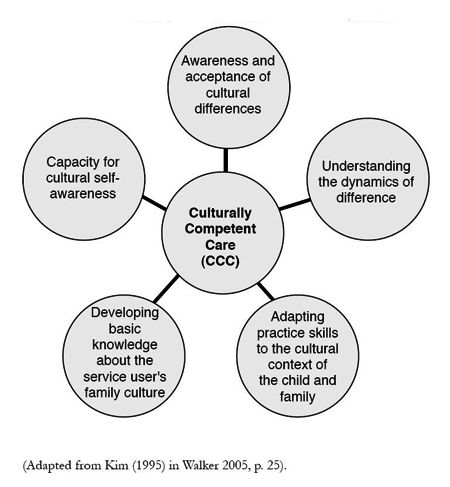
This model has much to offer in our understanding of children's religious and spiritual needs and in helping us to address them. It has the potential to move staff on from being unsure and overly cautious in their approach, equipping them to address these important needs more effectively. Culturally competent care increases professional confidence around inclusive practice and should help staff to recognise the importance of spiritual development for all looked-after children, irrespective of ethnicity. This is illustrated in the instance where a visitor to a secure unit commented:
I have encountered young people who feel that they are in some way controlled by evil. That what they have done is the result of this evil and that therefore there is nothing they can do to stop themselves. Others have talked of associating with people who have some sort of power over them, and they have experienced this as demonic power (Crompton, 2001, p. 95).
Culturally competent staff may feel more confident to address such views. By adopting culturally competent care, they will be more able to interpret these views in their proper context based on sound understanding of spiritual development and well-developed self-awareness (Allain, 2007).
In my experience as a regulator, residential child care still has some way to go in developing such cultural competence. Failure to understand religious and spiritual needs and differences can lead to institutional religious intolerance and the nullification of the importance of spirituality. Professionals, including residential and regulatory staff, need to be in touch with their own spirituality and to understand it as an essential element of human growth and development. This should at the very least include insight concerning the experiences and influences that have informed our own values and beliefs and how they affect our individual aspirations and ideas about our own spirituality. It may also include what helps us to feel at ease with ourselves and contributes to our sense of spiritual wholeness and worth.
I have seldom seen personal plans that have recognised the full potential of spiritual models for exploring, for example, issues of loss, resentment, guilt, the pain caused by un-forgiveness, or for developing self-esteem, self-awareness and personal values. This is not about proselytising but is concerned with supporting young people to look at themselves within the context of basic spiritual principles relevant to their background and culture. For example, where a young person is struggling with feelings of guilt these may have been contributed to, in part, by their religious background. It may well be helpful for staff to explore with the young person what their views are of “sin” and “evil” or the concept of “forgiveness”. This can potentially support young people to feel valued and to find solutions that promote some sense of spiritual wholeness, whether derived from organised religion or from a more humanistic understanding of spirituality.
Good reference resources exist to inform staff of the specific requirements and traditions of different cultures including personal care needs, diet, religious observance and identity (for example Millam, 1996 or Moore and Maclean, 2004); however these need to be explored proactively with young people through the personal planning process. The personal plan should include the details of which practices and observances are important to the young person (and/or their parents) and what support would help them to maintain these. This might, for example, include the need for uninterrupted time, space and privacy for prayer and reflection. Residential child care training needs to give greater consideration to spirituality. This should not be merely an adjunct to racial awareness training, nor simply learning about each others” traditions, but should encourage personal examination of the philosophical and moral underpinnings of care as practice (Crimmens and Milligan, 2005, p. 49-50).
Conclusion
Religious and spiritual beliefs are inextricable from personal and cultural beliefs but, despite being upheld by human rights legislation, they are not universally valued. Services for looked-after and accommodated children, including residential child care services, have a poor track-record in addressing these rights, seldom doing so more than superficially. We live in a changing culture which needs to move on from the sectarian past and embrace demographic change. Residential child care staff need training to develop culturally competent approaches to care which actively address the spiritual needs and development of all children and young people regardless of creed and ethnicity. Not only will this contribute to cultural differences being more highly valued, it will lead to significantly better understanding of the inner self, promoting feelings of safety and well-being. Services which fail to address children's cultural, religious and spiritual needs should be challenged both from within their own organisational structure and by regulators who need to have the cultural competence to do so.
References
Allain, L. (2007). An investigation of how a group of social workers respond to the cultural needs of black, minority ethnic looked after children. Practice, (19)2: 127-141.
Barn, R., Sinclair, R., & Ferdinand, D. (1997). Acting on principle: An examination of race and ethnicity in social services provision for children and families. London: British Agencies for Adoption and Fostering.
Berridge, D., & Brodie, I. (1998). Children's homes revisited. London: Jessica Kingsley. Care Commission (2008). Draft Single Equality and Diversity Scheme, 2008-2011. Dundee: Care Commission.
Carson, J. (2008). Children's education must be based on facts, not religious propaganda. Letter in The Scotsman, 17th September, 2008.
Christian Research/Church of Scotland (2003). Scottish Church decline in not inevitable: The report of the 2002 Scottish Church census. Glasgow: Scottish Catholic Media Office.
Crimmens, D. & Milligan, I. (2005). Facing forward: Residential child care in the 21st century. Lyme Regis: Russell House.
Crompton, M. (2001). Who am I? Promoting children's spiritual well-being in everyday life: A guide for all who care for children. Ilford: Barnardos.
Davis,R. (2008). Islam is a way of life. Community Care, 3rd July, 2008.
Howie, M. (2008). Bid to stop terror groups brainwashing young Scots Muslims. The Scotsman, 20 June, 2008.
Hyde, B. (2008). Children and spirituality: searching for meaning and connectedness. London: Jessica Kingsley.
Kelly, B. & Sinclair, R. (2005). Understanding and negotiating identity: Children from cross-community families in public care in Northern Ireland. Child and Family Social Work, 10: 331-342.
McBay, A. (2008). Only some beliefs count. Letter in The Scotsman, 31st July, 2008.
Millam, R. (1996). Anti-discriminatory practice: A guide for workers in childcare and education. London: Cassell.
Moore, R. & Maclean, I. (2004). Cultural sensitivity in social and health care. Rugeley: Kirwin Maclean Associates.
O'Loan, S., Poulter, A. & McMenemy, D. (2005). The extent of sectarianism online: Project report for Nil By Mouth. Glasgow: University of Strathclyde.
Oxford English Dictionary (2008). Accessed on 22nd November, 2008, at http://www.askoxford.com
Rose, G. (2008). Prejudiced neighbours make false claims against migrants. The Scotsman, 14th May, 2008.
Ross, S. (2008). Madrassas “should teach how to deal with jibes”. The Scotsman. 2nd December, 2008.
Scottish Executive (2005a). Religious discrimination and sectarianism in Scotland: A brief review of evidence (2002-2004). Edinburgh: The Stationery Office.
Scottish Executive (2005b). National Care Standards: Care homes for children and young people. Second edition. Edinburgh: The Stationery Office.
Scottish Executive (2005c). National Care Standards: Care homes for older people. Second edition. Edinburgh: The Stationery Office.
Scottish Government (2007a). Statistics publication notice: Children looked-after statistics, 2006-07. Accessed on 21st November, 2008, at http://www.scotland.gov.uk/Resource/Doc/204913/0054519.pdf
Scottish Government (2007b). Scotland's population 2007: The Registrar General's annual review of demographic trends: 153rd Edition. Accessed on 22nd November, 2008, at http://www.gro-scotland.gov.uk/files1/stats/scotlands-population-2007-theregister- generals-annual-review-153rd-edition/j994404.htm#4
Scottish Social Services Council (2002). Codes of practice for social service workers and employers. Dundee: Scottish Social Services Council.
Scottish Social Services Council (2008a). Residential child care: Equal opportunities information. Received by e-mail following direct enquiry to SSSC. 8th December, 2008.
Scottish Social Services Council (2008b). Migrant workers research: A report to the Scottish Social Services Council. Dundee: Scottish Social Services Council.
Stevens, I. & Boyce, P. (2006). The National Care Standards: Hearing the voices of young people in residential care. Scottish Journal of Residential Child Care, (5)1: 1-15.
TOPSS (2008). Practice learning in regulation workbook. Appendix Three, Adaptation for Scotland of the National Occupational Standards for inspectors of health and social care for adults and children. Cambridge: Anglia Ruskin University.
United Nations (1989). Convention on the rights of the child. Geneva: United Nations High Commissioner for Human Rights.
Wade, J., Mitchell, F., & Baylis, G. (2005). Unaccompanied asylum-seeking children: The response of social work services. London: British Association for Adoption and Fostering.
Walker, S. (2005). Culturally competent therapy: Working with children and young people. Basingstoke: Palgrave-Macmillan.
This feature: Barratt , C. (2009). Supporting the religious and spiritual needs of looked-after and accommodated children in Scotland. Scottish Journal of Residential Child Care, Volume 8 No 1 pp 38-50